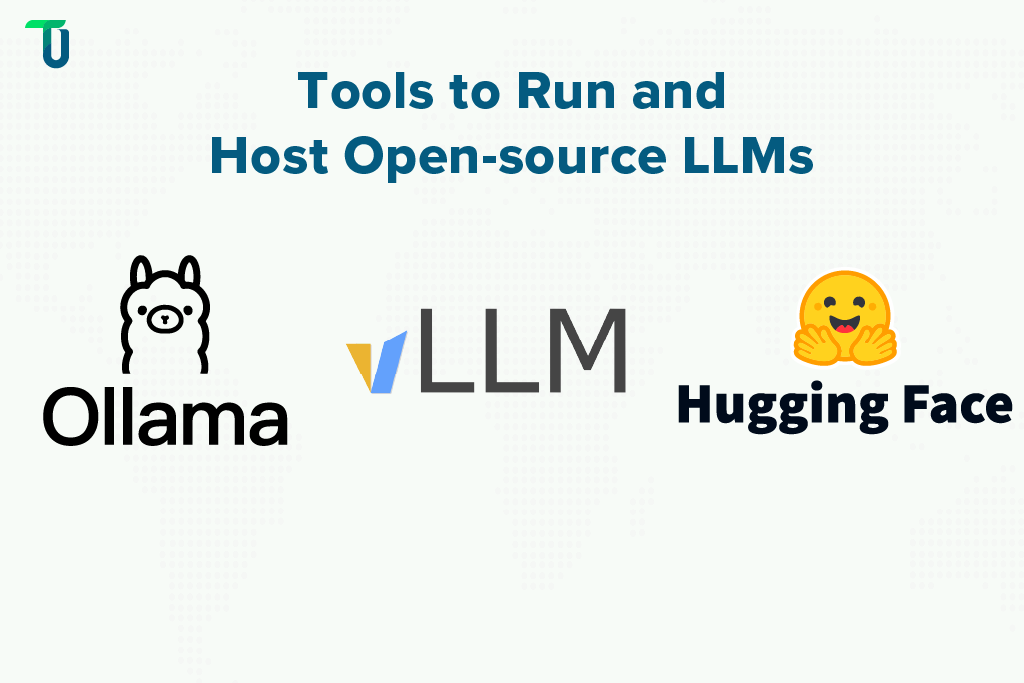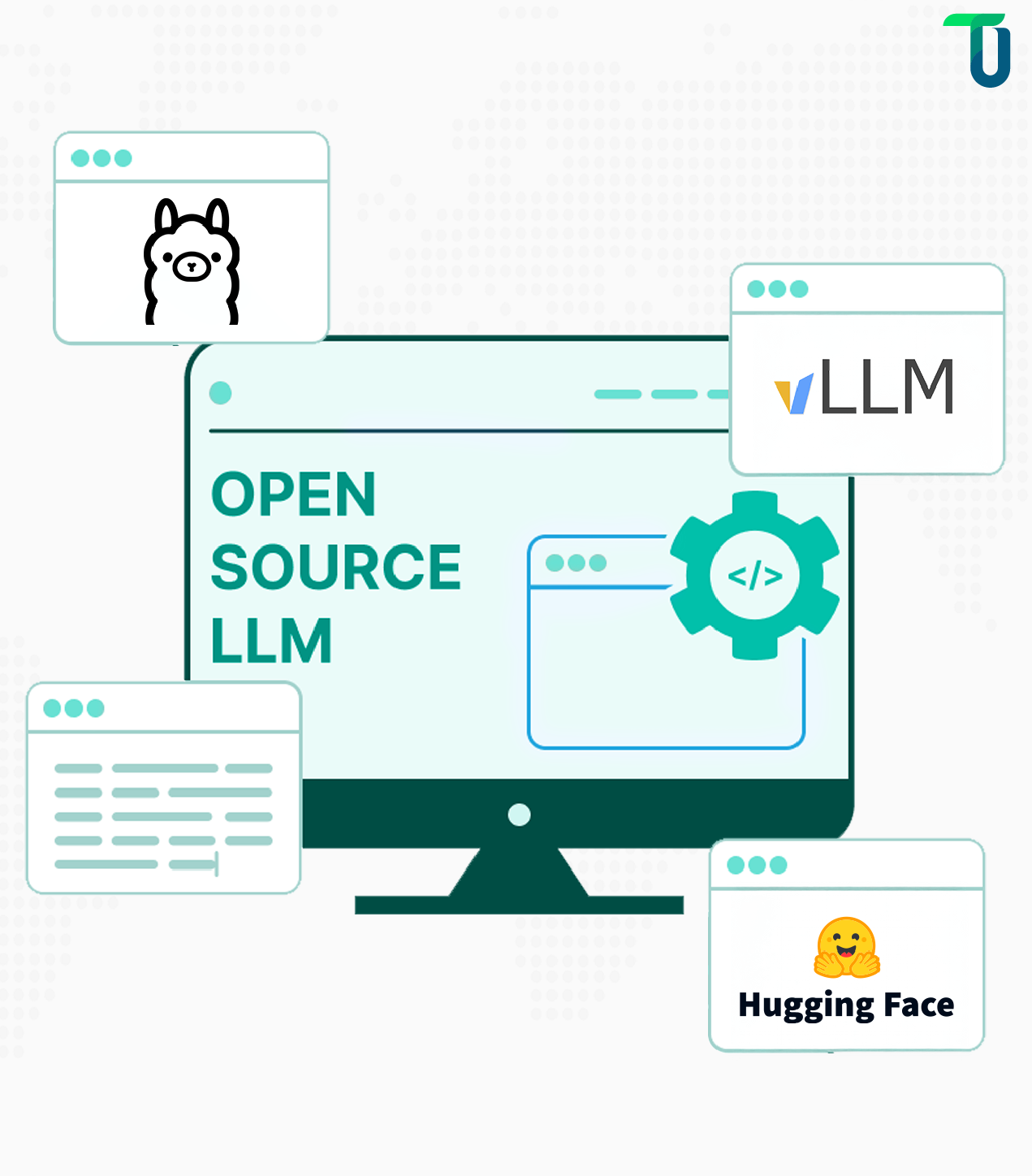Simplifying Hosting and Running Open-source LLMs with the Right Tools
Whether you are using a proprietary or open-source large language model, you need some level of LLMOps. There are now several LLMOps tools and LLM deployment tools designed to streamline these tasks across both cloud and self-hosted environments. LLMOps is a set of practices focused on making the deployment, maintenance, and scaling of LLMs efficient, cost-effective, and sustainable in real-world applications.
For Proprietary or Closed LLMs, the model-providing companies majorly handle LLMOps tasks like deployment, scaling, maintenance, and monitoring as part of their service offerings. And the user must manage tasks like integrating the LLM’s APIs into their applications and managing how the models are used in specific workflows. Other LLMOps tasks that the user should perform include, monitoring costs based on their usage patterns, handling the scaling of the application when the LLM scales, and ensuring their application stays compatible with the new versions of LLM. Equally important is focusing on LLM evaluation and observability to track model performance and reliability over time
Contrarily, for Open-source LLMs, you must handle the model’s entire lifecycle, including its deployment, scaling, maintenance, monitoring, fine-tuning, and optimization. The greater responsibility of handling end-to-end LLMOps to manage open-source LLMs can feel daunting But with access to the right LLM deployment platforms, even teams without deep infrastructure expertise can succeed in deploying open-source LLMs efficiently. We’ll discuss three tools popularly used to host and run LLMs locally- Ollama, vLLM, and Hugging Face.

Ollama: Deploy and Manage Open-source LLMs Locally
Ollama is an open-source tool or platform that simplifies the deployment, management, and scaling of LLMs locally. It provides a lightweight, user-friendly framework that allows running LLMs like Llama, Phi, Mistral, etc., efficiently without requiring extensive infrastructure or cloud dependencies. This makes it ideal for experimenting with lightweight LLMs for local deployment, particularly when speed and resource optimization are priorities. This eliminates the complexities and costs associated with cloud-based solutions and gives you complete control over data privacy and security.
Key Features of Ollama
Complete Management of LLMs Locally: Ollama provides complete control over open-source LLMs, allowing users to easily download, update, and delete them directly on their system. This helps maintain strict control over data security. It’s also a powerful option if you're looking to deploy open-source LLMs locally without relying on the cloud. It also enables tracking and managing different versions of LLMs in both research and production settings. This helps to test or roll back to specific versions to achieve the best outcomes or troubleshoot issues.
Flexible Control with Command-Line and GUI Options: This tool utilizes a command-line interface (CLI), offering users fine-grained control over their LLMs. So, you can swiftly execute commands to download, run, and manage models, making it a great option if you prefer working directly in the terminal. It also integrates with third-party graphical user interfaces (GUIs), like Open WebUI which helps you interact with models through an intuitive interface, providing an alternative if you favor a more visual approach and want a simpler, more user-friendly experience.
Seamless Multi-Platform Support: It supports multiple operating systems like macOS, Linux, and Windows to fit into your existing workflows, irrespective of the platform you use. Thanks to Linux compatibility, you can install it on a virtual private server (VPS) for remote access and management. So, it provides more scalability to large-scale projects or teams that need to collaborate across different locations.
Ollama can be utilized for versatile use cases like:
- creating local, privacy-focused chatbots for businesses,
- enabling offline machine learning research for universities, and
- developing AI applications across industries.
Struggling with LLM-based AI Applications?
We can help you navigate the complexities of hosting, managing, and optimizing LLMs to improve AI performance.
vLLM: Optimize and Scale Open-source LLMs
vLLM (Virtual Large Language Model) is an open-source library that has evolved into a community-driven project designed for high-performance hosting and running of LLMs. It serves as a high-performance LLM server that’s capable of managing large-scale LLM model hosting across GPU infrastructure. It excels at running large models at scale, with efficient memory management and the ability to handle multiple requests in parallel. Academic benchmarks confirm its advantage—vLLM’s PagedAttention mechanism delivers 2×–4× higher throughput compared to FasterTransformer and Orca, while maintaining low latency. It focuses on the fast processing of LLMs with reduced latency and improved throughput and works well with complex models requiring heavy computational resources.
Key Features of vLLM:
Multi-GPU Efficiency: vLLM ensures the high performance of LLMs by optimizing multi-GPU setups for smooth parallel processing. This allows for a more effective distribution of model computations, minimizing bottlenecks and boosting overall throughput. vLLM’s native support for multi-GPU configurations ensures that workloads are efficiently managed, enhancing system performance.
Dynamic Continuous Batching: Rather than relying on fixed batch sizes, vLLM introduces continuous batching for the dynamic distribution of tasks. This approach improves resource management and efficiency in environments with variable workloads. With continuous management of input streams, idle time is reduced, especially for real-time applications that require constant data flow.
Speculative Decoding for Faster Inference: To minimize latency, vLLM uses speculative decoding to predict and validate future tokens in parallel. This preemptive approach helps speed up inference times, making it ideal for latency-sensitive applications like chatbots and real-time text generation. It’s one of the key innovations that sets vLLM apart in enhancing the responsiveness of large language models.
Optimized Memory Usage with Embedding Layers: vLLM uses optimized memory management to scale LLMs effectively. Its embedding layers are finely tuned for memory efficiency, ensuring that GPU memory is used in a balanced way. This optimization helps prevent memory overloads without compromising performance.
Flexibility with LLM Adapters: This tool supports LLM adapters, allowing developers to fine-tune models without entirely retraining them. This modular approach saves both time and resources, offering a more efficient path to customizing LLMs for specialized applications. So, developers get greater adaptability to work on specific use cases.
The use cases of vLLM include:
- fast-response chatbots and virtual assistants,
- real-time content generation for marketing and media,
- sentiment analysis for social media and market research,
- improves the efficiency of machine translation services, ensuring faster and more accurate results.
- vLLM also stands out among open-source LLM deployment tools, especially for latency-sensitive and production-grade inference tasks where approaches like multi-agent AI for scalability can further enhance system efficiency.
Hugging Face: Build and Manage Open-source LLMs
Hugging Face is a comprehensive platform for hosting, fine-tuning, and deploying open-source LLMs. It is also one of the most reliable platforms for commercial and open-source LLMs in production, supporting flexible deployment models. Its adoption reflects this credibility—over 7,700 verified companies worldwide use Hugging Face in production, and the company reached a $4.5 billion valuation backed by $396 million in funding. By end-2023, Hugging Face achieved $70 million in ARR, a 367% increase from the previous year. It offers both cloud-based and on-premise solutions and provides access to a large range of models and tools. Backed by a large community-driven repository, it is widely used to build both small and large-scale AI applications.
Key Features of Hugging Face
Transformers Library: This flagship offering provides pre-trained models for natural language processing (NLP), computer vision, and audio tasks. It supports popular architectures like BERT, GPT, T5, and more, making it easy to fine-tune and deploy models for specific use cases.
Model Hub: It is a vast repository of pre-trained models contributed by the community and Hugging Face. With thousands of models available, users can find and use models for tasks like text classification, translation, summarization, and image generation.
Datasets Library: It provides access to a wide range of datasets for training and evaluation. It includes tools for data preprocessing, splitting, and streaming, making it easier to work with large datasets efficiently.
Integration with Popular Frameworks: Hugging Face integrates seamlessly with frameworks like PyTorch, TensorFlow, and JAX, allowing users to work within their preferred ecosystem.
Inference API: With a hosted inference API, Hugging Face allows developers to run open-source LLMs in production without the need for a complex infrastructure setup. It supports scalable, low-latency inference, making it ideal for real-time applications. If you need a platform that supports both commercial and open-source LLMs in production, Hugging Face provides all the components required to scale securely.
Hugging Face can be used to build applications like:
- chatbots,
- content moderation,
- healthcare tools,
- financial analysis, and
- e-learning systems.
With its pre-trained models, user-friendly tools, and vibrant community, it facilitates innovation in AI
OLLMA vs vLLM vs Hugging Face
While all three popular tools- Ollama, vLLM, and Hugging Face, come with their unique features to simplify hosting and running open-source LLMs locally, let’s have a quick comparative analysis to understand them better. Wondering what are the best tools for running LLMs locally or if there are tools designed specifically to deploy LLM models with both cloud and self-hosted options? This table should help you decide.
Please refer to the below table that compares these tools on different factors like ease of use, performance, scalability, integration & flexibility, model support, deployment, and use case.
| Factor | Ollama | vLLM | Hugging Face |
|---|---|---|---|
| Ease of Use | Very user-friendly | Requires more technical setup | User-friendly with extensive docs |
| Performance | Optimized for smaller models | Highly optimized for large-scale models | Good performance with scaling options |
| Scalability | Limited | High | Scalable with managed services |
| Integration & Flexibility | Limited flexibility | High flexibility for advanced users | High flexibility, integration into multiple tools |
| Model Support | Popular open-source models | Popular open-source models | Extensive (Transformers, etc.) |
| Deployment | Local | Cloud/On-premise | Cloud/On-premise |
| Use Case | Ideal for small to medium-scale | Best for high-throughput, enterprise-level use | Great for research, fine-tuning, and both small and large-scale use |
Choosing between these tools depends largely on your specific use case:
- Opt for Ollama if you prioritize ease of use and low latency in local environments.
- Choose vLLM if you need high throughput and scalability in server-side deployments.
- Select Hugging Face if you require access to a wide range of pre-trained models and extensive resources for complete LLM management.
Leverage the Benefits of Open-Source LLMs for Your AI Solutions
Hosting and running open-source models doesn’t have to be a challenge. We’ve explored how effective LLMOps, using tools like Ollama, vLLM, and Hugging Face, can help streamline the process. Selecting the right tools based on your project’s unique requirements is crucial. Whether you’re choosing a solution for hosting LLMs, exploring hybrid RAG-based AI architectures, looking for the fastest inference platform for hosting open source models, or simply wondering how to deploy open source LLMs effectively, the key is to align the tools with your workload, scalability, and customization needs. It can provide significant benefits like cost savings, flexibility, data privacy, security, and, most importantly, the ability to customize AI solutions tailored to your specific business needs—often through approaches like LLM fine-tuning for custom AI solutions—tailored to your specific business needs.”
Depending on your use case, you can choose to work exclusively with open-source LLMs or adopt a hybrid approach by combining proprietary and open-source models within your AI systems.
Whether you’re looking to build AI solutions from scratch or need support optimizing existing applications, our comprehensive AI services are here to help. These platforms are especially useful when working with open-source LLMs for local deployment, whether for experimentation or production-grade AI visibility. Also, be sure to check out our success stories to see how we’ve helped clients achieve real-world results with custom-built AI solutions.
Ready to take your AI solutions to the next level?
We can help you implement open-source or hybrid LLM approaches to drive your digital transformation forward.
Frequently asked questions
What are open-source LLMs?
Open-source large language models (LLMs) are AI models with publicly available source code, enabling anyone to use, modify & share them. Examples include GPT-J, LLaMA, Mistral. These models offer transparency, customization & cost-effective alternatives to proprietary models like GPT-4.
Why are open-source LLMs important?
Open-source LLMs make advanced AI accessible and affordable, fostering innovation globally. They promote transparency, trust, and customization, enabling users to adapt AI to their needs. This encourages collaboration and accelerates AI progress.
What are the common challenges with open-source LLMs?
Common challenges with open-source LLMs include high computational costs and maintenance for updates and security. These issues can make them less accessible for smaller teams. Ongoing support is often needed to keep models current and secure.
What are the best open-source LLMs and their ideal use cases?
LLaMA 3.1 – Great for text generation and coding assistance.
Vicuna – Optimized for chatbot interactions and conversational AI.
Mistral 7B – Efficient for coding and content generation.
GPT-NeoX-20B – Scalable model for large-scale content and sentiment analysis.
BLOOM – Best for multilingual applications and translation.
What are the best tools for hosting and running open-source LLMs locally?
Top tools for hosting and running open-source LLMs locally include Ollama, vLLM, and Hugging Face. Ollama is great for lightweight deployments, vLLM excels in high performance and scalability, and Hugging Face is best at managing and fine-tuning LLMs with extensive support.
How does Ollama compare to Hugging Face for running open-source LLMs?
Ollama is ideal for lightweight, local deployments and easy use in smaller projects. Hugging Face offers a broader range of models, fine-tuning tools, and cloud solutions, making it better suited for larger-scale applications and research.
What is vLLM, and why is it used for open-source LLMs?
vLLM is an open-source library for high-performance hosting and scaling of LLMs. It excels in multi-GPU efficiency, dynamic batching, and low-latency applications. It's ideal for real-time tasks like chatbots, content generation, and sentiment analysis.
Can I use open-source LLMs instead of proprietary models like GPT-4?
Yes, open-source LLMs like GPT-J or Mistral 7B can be cost-effective alternatives to GPT-4. While they may not match GPT-4's performance, they offer better control over data privacy, customization, and long-term savings. They're ideal for use cases that don't require cutting-edge capabilities.
What are the key benefits of using open-source LLMs over proprietary models?
The key benefits of using open-source LLMs include:
- Cost savings: No per-use fees, making it cheaper in the long run.
- Data privacy and security: Hosting models locally ensures sensitive data stays on-premise.
- Customization: Ability to fine-tune models for specific use cases.
- Flexibility: Freedom to modify and adapt models as needed.
- Community support: Access to a large community for troubleshooting and innovation.

